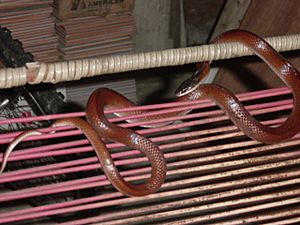Dark-headed red false boa facts for kids
Quick facts for kids Pseudoboa neuwiedii |
|
|---|---|
 |
|
| Pseudoboa neuwiedii in a house in El Limón, Venezuela | |
| Conservation status | |
| Scientific classification | |
| Genus: |
Pseudoboa
|
| Species: |
neuwiedii
|
| Synonyms | |
The dark-headed red false boa, also known as Pseudoboa neuwiedii, is a type of snake. It belongs to the Colubridae family, which is a very large group of snakes. This snake is special because it is found only in certain parts of northern South America. It is sometimes called Neuwied's false boa.
Contents
Where Does This Snake Live?
The dark-headed red false boa lives in many countries in South America. You can find it from Colombia all the way to The Guianas. It also lives in Brazil, especially near the Amazon River. This snake can also be found on the islands of Grenada and Trinidad and Tobago.
What Does Pseudoboa neuwiedii Look Like?
This snake can grow to be about 1 meter (or 39 inches) long. That's about the length of a baseball bat!
Its back is usually reddish-brown. It might have a few small black spots scattered on it. The top of its head and neck are dark, either black or dark brown. Sometimes, it has a yellowish band or collar around its head. Its belly is a yellowish color.
This snake does have venom. However, its teeth make it hard for the snake to inject the venom easily. The venom can affect blood clotting, but it is not usually a big danger to humans.
How Does This Snake Behave?
The dark-headed red false boa is a very strong snake. It is known for being a powerful constrictor. This means it squeezes its prey tightly until the animal cannot breathe.
What Does This Snake Eat?
This snake is not picky about its food. It eats almost any animal it can catch and overpower. Sometimes, these snakes even eat other snakes that are as big as or even bigger than themselves!
How Does This Snake Have Babies?
Pseudoboa neuwiedii lays eggs. This means it is an oviparous animal. The female snake lays eggs, and the baby snakes hatch from them later.
See also
 In Spanish: Pseudoboa neuwiedii para niños
In Spanish: Pseudoboa neuwiedii para niños


